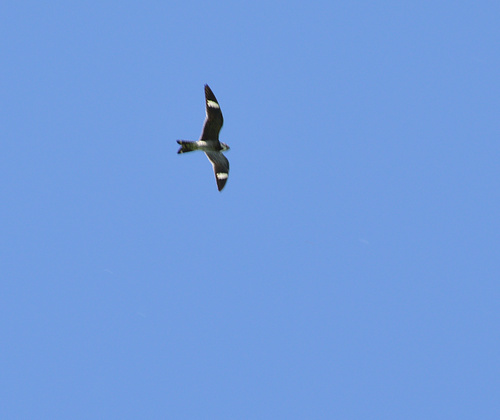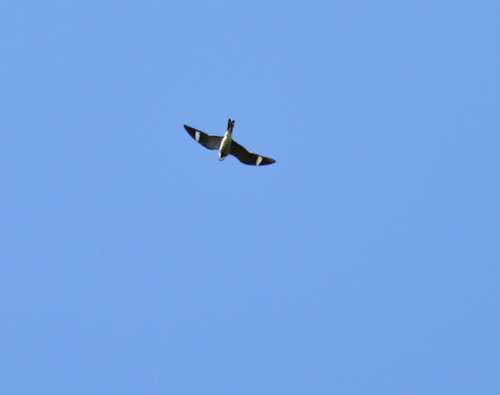
Wildflowers and booming nighthawks at South March
June 18th, 2017
On May 27th I hiked the west loop of South March Conservation Forest. With the filling out of the trees, the spring ephemerals had faded--just a few lingering and wilting White Trilliums. But a fresh crop of beauty had sprung up to replace it.

1680x1050 wallpaper
Pale Corydalis grows in rocky clearings in places like South March (especially the rugged west side of it) and the Carp Ridge barrens. It is one of my favorite wildflowers. The blossoms are very small and delicate, though--you have to really get down close to appreciate their beauty.

Wild Columbine, wallpaper available

Wild Columbine

Canada Mayflower, wallpaper available

A male Rose-Breasted Grosbeak surveys his territory. South March is one of the best places in Ottawa to see these beautiful birds in their nesting habitat.
When I wasn't focusing on flowers and songbirds, I was marvelling at the nighthawks. These unusual birds (which despite the name are not hawks, but members of the nightjar family) also breed in South March Conservation Forest. Their "hawking" is for flying insects, their sole source of food, and I would guess that the large mosquito population in South March is one reason for the large nighthawk population. (Whatever the reason, it is a very good thing. Like many dedicated insectivores, nighthawks are in decline, probably because of our overuse of pesticides.) They nest on open ground, but they and their young are so well-camouflaged that to actually find a nest site would be a once-in-a-lifetime event (hasn't happened to me yet...) Unless you are very, very lucky, you only ever see them in flight, usually just a silhouette in the sky.
Nighthawks are typically more active in the evening hours. But in the west end of South March at this time of year, you can see males in the middle of a sunny afternoon, circling high overhead, *peent*ing and diving to impress prospective mates. Spring fever! A nighthawk's dive is an acoustic marvel. He folds his wings and plummets downward at high speed, dropping 100 feet or more. As he bottoms out, he flexes his wings and produces a whooshing or zooming sound, reminiscent of a race car. Even though he is usually still high above you when this happens, the sound seems to come from right beside your ear.



Nighthawks are easily identified by the white bands across their wings, both above and below, visible even at a great distance.
My best birding of the day happened after I was back out of the forest, along the railroad tracks (typical!), although it was all too distant for good photographs. A pair of American Kestrels was flying around calling loudly ("klee! klee! klee!"), apparently setting up to nest. The sound drew two male Indigo Buntings and a Chestnut-Sided Warbler (potential meals for a kestrel...) out of the bushes to look around.
Closer to Huntmar, I was excited to hear an unusual insect-like song consisting of three buzzes, the last two on a lower pitch ("bee-bzz-bzz"). That's Golden-Winged Warbler song, something we seldom hear in Ottawa. There are just a handful of places where one or two known breeding pairs nest. I knew that this spot was one of them, but I'd never heard or seen them before, in fact I'd never seen Golden-Winged Warblers period, with the exception of an outing to Chaffey's Lock in 2011, when I got my lifer.
Golden-Wingeds are another declining species. One reason may be their specialized habitat: they nest in early-successional young growth--the kind created by fire or human disturbance--but immediately after their young fledge, they move into adjacent mature forests. (It is theorized that this is to provide better cover for the naive fledglings so that they don't get picked off by, say, a pair of kestrels nesting a few doors down.) So they require a sort of patchwork of habitat. Once, this habitat would have been regularly created by small forest fires. Now, with humans practicing fire suppression, Golden-Wingeds are dependent on us to somehow create these early-successional patches, while leaving mature forest standing nearby.
He was elusive, hard to spot in the dense tangle that his "bee-bzz-bzz" emanated from, and I was unable to descend the tracks and go in there to find him. But after about a half hour of patient watching, I got a distant but unmistakable view of the singing male. Ottawa first!
June 18th, 2017
On May 27th I hiked the west loop of South March Conservation Forest. With the filling out of the trees, the spring ephemerals had faded--just a few lingering and wilting White Trilliums. But a fresh crop of beauty had sprung up to replace it.

1680x1050 wallpaper
Pale Corydalis grows in rocky clearings in places like South March (especially the rugged west side of it) and the Carp Ridge barrens. It is one of my favorite wildflowers. The blossoms are very small and delicate, though--you have to really get down close to appreciate their beauty.

Wild Columbine, wallpaper available

Wild Columbine

Canada Mayflower, wallpaper available

A male Rose-Breasted Grosbeak surveys his territory. South March is one of the best places in Ottawa to see these beautiful birds in their nesting habitat.
When I wasn't focusing on flowers and songbirds, I was marvelling at the nighthawks. These unusual birds (which despite the name are not hawks, but members of the nightjar family) also breed in South March Conservation Forest. Their "hawking" is for flying insects, their sole source of food, and I would guess that the large mosquito population in South March is one reason for the large nighthawk population. (Whatever the reason, it is a very good thing. Like many dedicated insectivores, nighthawks are in decline, probably because of our overuse of pesticides.) They nest on open ground, but they and their young are so well-camouflaged that to actually find a nest site would be a once-in-a-lifetime event (hasn't happened to me yet...) Unless you are very, very lucky, you only ever see them in flight, usually just a silhouette in the sky.
Nighthawks are typically more active in the evening hours. But in the west end of South March at this time of year, you can see males in the middle of a sunny afternoon, circling high overhead, *peent*ing and diving to impress prospective mates. Spring fever! A nighthawk's dive is an acoustic marvel. He folds his wings and plummets downward at high speed, dropping 100 feet or more. As he bottoms out, he flexes his wings and produces a whooshing or zooming sound, reminiscent of a race car. Even though he is usually still high above you when this happens, the sound seems to come from right beside your ear.



Nighthawks are easily identified by the white bands across their wings, both above and below, visible even at a great distance.
My best birding of the day happened after I was back out of the forest, along the railroad tracks (typical!), although it was all too distant for good photographs. A pair of American Kestrels was flying around calling loudly ("klee! klee! klee!"), apparently setting up to nest. The sound drew two male Indigo Buntings and a Chestnut-Sided Warbler (potential meals for a kestrel...) out of the bushes to look around.
Closer to Huntmar, I was excited to hear an unusual insect-like song consisting of three buzzes, the last two on a lower pitch ("bee-bzz-bzz"). That's Golden-Winged Warbler song, something we seldom hear in Ottawa. There are just a handful of places where one or two known breeding pairs nest. I knew that this spot was one of them, but I'd never heard or seen them before, in fact I'd never seen Golden-Winged Warblers period, with the exception of an outing to Chaffey's Lock in 2011, when I got my lifer.
Golden-Wingeds are another declining species. One reason may be their specialized habitat: they nest in early-successional young growth--the kind created by fire or human disturbance--but immediately after their young fledge, they move into adjacent mature forests. (It is theorized that this is to provide better cover for the naive fledglings so that they don't get picked off by, say, a pair of kestrels nesting a few doors down.) So they require a sort of patchwork of habitat. Once, this habitat would have been regularly created by small forest fires. Now, with humans practicing fire suppression, Golden-Wingeds are dependent on us to somehow create these early-successional patches, while leaving mature forest standing nearby.
He was elusive, hard to spot in the dense tangle that his "bee-bzz-bzz" emanated from, and I was unable to descend the tracks and go in there to find him. But after about a half hour of patient watching, I got a distant but unmistakable view of the singing male. Ottawa first!
| ← | → |

Mike
June 21st, 2017 at 3:44 pm
Nice finds... I have fond memories of the Nighthawks from other occasions.
I would guess GWW's like the new construction areas, especially when they're cut and then left unused for a while. Was there any report of them around the Lime Kiln burn zone, or might there be in coming years?
Suzanne
June 21st, 2017 at 10:21 pm
Good question...maybe in the coming years! I don't know if it was enough of a fire to make room for GWW habitat though. Maybe in that open corridor they created as a fire break?